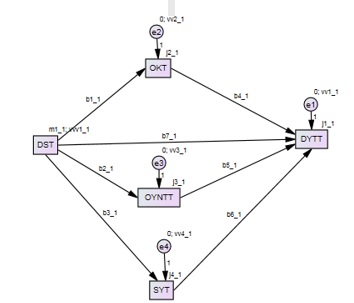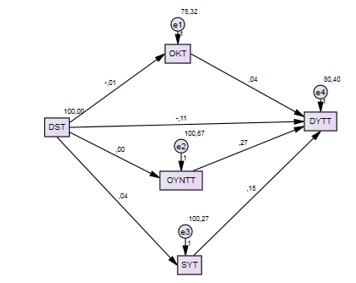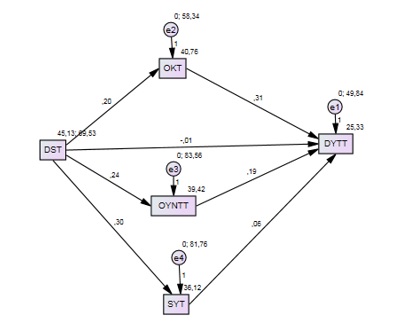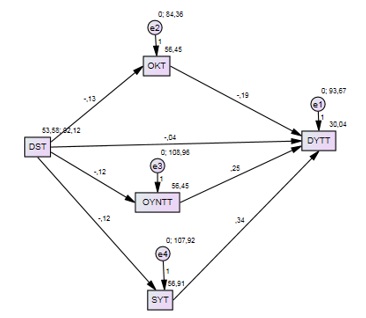Abstract
This study intends to test the relationship between the assessment competencies and attitudes of secondary school and high school teachers and their teacher self-efficacy perceptions and assessment duration by all group and gender variables. It was carried out in Sivas province during the 2016-2017 academic year. It was intended to find out the relationships between assessment competences and attitudes of secondary school and high school teachers (DYT) and their teacher self-efficacy perceptions covering the dimensions of Efficacy for Student Engagement (OKT), Efficacy for Instructional Strategies (OYNTT) and Efficacy for Classroom Management (SYTT) and duration of experience (DST). Also multiple group analysis was applied to test whether such relationships vary by gender. This is a correlational study as a type of quantitative research because it investigates the relation between the related variables. As a result, duration of experience hasn’t meaningful correlation with all variables in the all group. But it changes according to gender. Otherwise, there is meaningful correlation between teacher efficacy and assessment competence and attitudes. Also we can see difference between male and female teachers according to this correlations. In male group the strongest predictor is efficacy of classroom management, in female group it is efficacy for instructional method.
Keywords: Teacher self-efficacyassessment qualificationassessment attitudeefficacy for student engagementefficacy for school managementefficacy for instructional method
Introduction
Teacher competence has been one of the most widely studied topics lately. Competence is defined as "the skills, knowledge and abilities needed to perform a task and fulfil the responsibilities required by the task" (Şahin, 2004). According to Mansfield (1991), competence areas must include detailed and behavioural specific definitions of the skills and capabilities an employee needs to be effective in their work. According to Tyler (1978); competence is “a certain skill, something an individual knows how to do.” The Ministry of National Education sets out “teachers' competences to realize a number of goals such as contributing to transfer of the identified goals to students; making information sharing more effective; creating a system for comparing and contrasting teachers' qualities and qualifications; balancing the social expectations for the status and quality of the teaching profession; creating a comprehensible and reliable source as a basis for teachers' professional development, ensuring a language unity which includes the common terms and definitions to be used in discussing the level of professional teaching at the national level; defining teachers' knowledge, skills, attitudes and values to promote their recognition and elevation of their status in the society; providing opportunities for students to "learn to learn” ; and creating quality assurance for parents and the society by making the duties of teachers transparent” (MEB, 2008).
MoNE (2006) describes teacher competence as “the knowledge, skills and attitudes required for teachers who are to put into practice the instruction programs developed for effective teaching and learning programs and who are to prepare students for the 21st century. Tschannen-Moran and Woolfolk Hoy (2001) define teacher competence as “teachers' beliefs about showing the behaviours necessary to successfully perform their teaching task in a particular context and to change student behaviours”. According to Şahin (2004), teacher competence is a collection of information, skills, attitudes and personality characteristics necessary for effective performance in different teaching contexts. Kahyaoğlu and Yangın (2007) emphasize that it is related to teacher competence to bring students to the desired level in education.
One of the qualifications teachers should have in the pedagogical area is assessment (MEB, 2008). Assessment can be defined as a decision-making process about measured characteristics of an individual or object by comparing the results of measurement with criterion or a set of criteria (Alıcı, 2008).
Also effective and accurate measurement and assessment can be possible with our teachers' knowledge, skills and attitudes, namely their competence, in the field of measurement and assessment. Turgut (1997) stresses that measurement and assessment qualifications required of teacher candidates include determining the aim of teaching, preparing questions appropriate for the aims, developing an appropriate measurement tool, applying the measurement tool, analyzing and assessing.
Another important working area of teacher competence is regarded as self-efficacy.
Self-efficacy is also defined as the belief in starting and continuing a task in a way that can have an effect on what is happening around them (Bandura, 1994). Bandura emphasizes that self-efficacy has four pillars as the individuals' own experience, their emotional status related to their mental state at the time of a behaviour, their indirect experiences gained by seeing others' successes, and verbal persuasion originating from the words and advice heard from others. Taken all this into account, higher self-efficacy beliefs can also affect their cognitive processes by causing individuals to set themselves higher goals and be consistent in the decisions they make (Locke and Latham, 1990).Tschannen-Moran and Woolfolk-Hoy (2001) describe teacher self-efficacy as teachers' belief in their ability to bring student's participation and learning to the desired levels even in the case of students who are improbable or hard to be motivated. Teacher self-efficacy is among the leading variables showing high and positive correlation in teacher behaviors and student learning outcomes (Ashton and Webb, 1986; Gibson and Dembo, 1984). Teacher self-efficacy is also seen to be highly correlated with teaching performance (Riggs et al.,1994), enjoying teaching (Watters and Giııns, 1995), and student achievement (Midgley, Feldlaufer and Eccles, 1989).
Problem Statement
Bearing all these in mind; this study intends to test the relationship between the assessment competencies and attitudes of secondary school and high school teachers and their teacher self-efficacy perceptions and assessment duration by all group and gender variables. The theoretical model formed in line with the theoretical framework is given in Figure

Research Questions
The aim of this study, answer was sought to following questions:
Is duration of experience a significant predictor of teacher self-efficacy dimensions as student engagement, instructional strategies and classroom management, and assessment competence and attitudes?
Are assessment competence and attitudes a significant predictor of teacher self-efficacy dimensions as student engagement, instructional strategies and classroom management?
These relationships were examined to find out whether or not they differ between male and female teachers.
Purpose of the Study
This study was carried out in Sivas province during the 2016-2017 academic year. It was intended to find out the relationships between assessment competences and attitudes of secondary school and high school teachers (DYT) and their teacher self-efficacy perceptions covering the dimensions of Efficacy for Student Engagement (OKT), Efficacy for Instructional Strategies (OYNTT) and Efficacy for Classroom Management (SYTT) and duration of experience (DST). Also multiple group analysis was applied to test whether such relationships vary by gender.
Research Methods
This is a correlational study as a type of quantitative research because it investigates the relation between the related variables (Karasar, 2005). Correlational research examines the relationships between two or more variables (Fraenkel, Wallen ve Hyun, 2012; Karasar, 2005). In this study, the relationship was revealed between the variables of teachers' assessment qualifications and attitudes, teacher self-efficacy subscales and experience duration. In addition, the relationship was checked to see if it varies between male and female teachers.
Study Group
The study group consists of 228 teachers studying within Sivas province during the 2016-2017 academic year. The participants include 96 females and 132 males. As for level of school, 78 teachers work in middle schools, and the rest of 150 teach in high schools.
Data Collection Instruments
In this study, data were collected by using The
The Assessment Qualifications and Attitude Scale
A 24-item scale was developed with factor loadings ranging from .479 to .755. Rotation process showed that the scale consists of 4 factors as "Defining Assessment Qualifications", "Assessment Qualifications", "Negative Attitudes towards Assessment" and "Positive Attitudes towards Assessment". The Cronbach's Alpha internal reliability coefficient of the scale was .84. The explained variance value was found to be 48.435.The item-total test correlation values of the scale varies between .287 and .609. Consequently, a 4-factor 5-point Likert scale was developed titled "The Assessment Qualifications and Attitude Scale" (Yüksel, Acat, Ay and Pehlivan, 2015).
In addition, a Confirmatory Factor Analysis was conducted to test whether the factor structure of the scale was confirmed in our sample. As a result, fit index values were found to be (x2=1343.36, sd=734, p=0.00 RMSEA=.053, NNFI=.91, CFI=.92, IFI=.92, RMR= .059 and SRMR=.07), which indicates good level of fit.
The Teacher Self-Efficacy Scale
It is a 24-item, 7-point Likert-type scale. The form consists of three sub-scales to measure self-efficacy levels of teachers. Teacher self-efficacy is comprised of student engagement, instructional strategies, and classroom management. As the scale was adapted to Turkish, a Confirmatory Factor Analysis was conducted and it showed good fit in our study sample. Internal consistency reliability coefficient of the DZÖÖ-KF scale was reported to be .89, .98 and .98, respectively (Çapa, Çakıroğlu and Sarıkaya, 2005).
Also, CFA was performed on the factor structure of the scale to check whether it is verified in our sample, which yielded excellent fit indexes (x2=288.39, sd=149, p=0.00 RMSEA=.056, NFI=.92, CFI=.96, IFI=.96, RFI=.90, GFI=.91 and SRMR=.058).
Analysis of Data
The IBM SPSS 22 and AMOS 24 programs were used to test the analysis assumptions in the study and to determine the relationships between the test variables. CFA was conducted on the measurement instruments to verify model-data fit in our sample. As a result, sub-dimensions of both scales proved excellent levels of model-data compliance. Then, "Sample Size", "Missing Data" and "Extreme Values" required for the Structural Equation Model (SEM) were examined. "Multivariate Normality", "Multiple Linearity" and "Multiple Connection" assumptions were tested.
As one of the assumptions necessary for the SEM, there are various suggestions regarding sample size. It is argued that sample must include at least 200 participants (Kline, 2005), N> 50 + m (m number of independent variables) (Tabachnick and Fidell, 2007), at least 10 times of the number of observed variables (VanVoorhis and Morgan, 2007), significant probability of chi square in large samples (usually 200 and above) (Schumacker and Lomax, 2004), and minimum sample size of 100-150 for maximum likelihood method (Hair, Black, Babin, Anderson and Tatham, 2006). In our study, the assumption of sample size for the structural equality model is satisfied because the sample is comprised of 295 participants.
Because the structural equation model is sensitive to missing data and extreme values, existence of missing data was checked before starting data analysis, yielding no missing or extreme data in the study group. While determining the extreme values, Z scores were checked and it was checked whether there were any data outside +3 and -3. Apart from that, to determine the multivariate extreme values, "Mahalanobis Distances" were calculated. The study data showed no such values or missing data.
Univariate and bivariate normality tests are used to test multivariate normality. In this study, Kolmogrow Smirnov (KS) Test was applied for univariate normality. The significance test shows that the normality that resultant significance level above .05 is not achieved. If KS test results show that normality is not satisfied, skewness and kurtosis coefficients are examined. Skewness coefficients between +1 and -1 indicate that univariate normality is achieved. In this study, KS results showed that duration of assessment (KS = .056, p> .05) and student participation self-efficacy levels (KS=.057, p>.05) are not at significant levels. So these variables show normal distribution. For the other variables, skewness coefficients (DYTT=-.53OYNTT=-.472, SYT=-.447) are in the range of +1 -1, univariate normality is achieved. For bivariate normality, the scatter diagram matrix was examined.
As for multilinearity, it is related to linearity of the relationship between pairs of variables. Thus, the scatter diagram created for the bivariate normality matrix was examined, which revealed linearity between the pairs of variables.
As for multicollinearity hypothesis check, Variance Inflation Factor-VIF and tolerance values were checked (Cohen, Cohen, West and Aiken, 2003). In this study (DYTT=.809/1.206OKT=.288/3.470, OYNTT=.246/4.070, SYT=.294/3.399DST=.994/1.006), tolerance value is not equal to or less than .10 and VIF value is not equal to or greater than 10, indicating that there was no multiple link problem.
Findings
Table
As seen in Table
Once the relevant variables were satisfied, significance of the relationship between the variables was examined.
As Table
For the purposes of this study, fit indexes were not investigated since it intended to establish and test a theoretical model. The standard load values for the structural model confirmed as a result of the analysis are given in Figure

The relationships tested previously were then checked against variables of gender and school level.
Testing of the Model by Gender
The relationships were first examined in the entire group of participants. Then, it was repeated for female participants only. The path coefficients, t-values and significance levels obtained from the analysis of this model are shown in Table
Examination of the model variables in relation with female participants demonstrates that duration of service does not predict classroom management self-efficacy, which in turn does not significantly predict assessment competences and attitudes (p>.05). On the contrary, the other correlations were found at significant level (p<.05). More specifically, duration of experience is a significant predictor of efficacy for student engagement, instructional strategies and classroom management for female teachers (p<.05). In this scope, a unit's increase in duration of experience of female teachers brings about .20 units in student control self-efficacy, .24 units in efficacy for teaching methods, and .30 in efficacy for classroom management, respectively. As for significant predictors of assessment competencies and attitudes, student engagement and instructional strategies sub-dimensions under students teacher self-efficacy. One unit increase in student engagement behaviour leads to an increase of .31 units in assessment competence attitudes and .19 units in efficacy for instructional strategy.
The path coefficients for the model are shown on the path model tested in Figure

Testing of the Model (Males)
The relationships were also tested for male participants. The path coefficients, t-values and significance levels obtained from the analysis are displayed in Table
Testing of the variables in the model for males only revealed significant predictors of assessment competences and attitudes as efficacy for student engagement, instructional strategies and classroom management under teacher self-efficacy (p<.05). However, the relationships between the other variables were not at significant level. One unit increase in student engagement reduces male teachers' assessment competencies and attitudes by .19 units. On the other hand, increase of a unit in instructional strategies and classroom management leads to increase by .25 and .34 units, respectively.
The path coefficients for the model are shown on the path model tested in Figure

Conclusion
On the variables studied in this study, separate checks were conducted for the whole group, females, and males, respectively. All the three comparisons are given in Table 7.
As understood from Table
It is seen that duration of experience is not a predictor of assessment competencies and attitudes for any of the three samples. There seems no difference between males and females. In relation with the other relationships that does not differ between the two groups; student control and teaching methods seem to be predictors of assessment competence and attitude in both gender groups. This implies that efficacy for student engagement and classroom management behaviours play an important role in teachers' assessment competencies and attitudes. In both groups, it was seen that as efficacy levels for classroom management increase, assessment competence perception increases. In male group, as perception of efficacy for student engagement increases, it was seen that teachers' perceptions of assessment competence and attitudes decreases. On the contrary, as the perception of student engagement increases among female teachers, the perception of competence and attitude also increases.
Finally, classroom management self-efficacy seems to be a significant predictor of assessment attitudes among male teachers, it is not the case for female teachers.
As expected in the study, duration of the teachers' experience does not prove to be a predictor of teachers competences. It was seen that teacher self-efficacy perception is not affected from their experience period. Besides, despite differences in assessment competences of male and female teachers, teacher self-efficacy seems to be important in general. Departing from this, other variables related to teacher self-efficacy can be investigated in the future. It can be investigated whether these variables vary between female and male teachers. In addition, other variables related to teachers' assessment competence and attitudes can be studied. Also future studies might explore the way the variables discussed in this study differ between secondary and high school teachers.
References
- Alıcı, D. (2008). Öğrenci performansının değerlendirilmesinde kullanılan diğer ölçme araç ve yöntemleri, Ed. S. Tekindal. Eğitimde Ölçme ve Değerlendirme, 127-165.
- Ashton, P. T., & Webb, R. B. (1986). Making a difference: Teachers' sense of efficacy and student achievement. Nesv York: Longııtan.
- Bandura, A. (1977). Self-efficacy: Tosvard a unifying theory of behavioral change. Psychological Review 84 (2), 191-215.
- Biggs, J. & Moore, P. (1993). The process of learning, 3rd. ed. Australia: Prentice Hall.
- Cohen, J. (1992). Statistical Power Analysis. Current Directions in Psychological Science, 1 (3), 98-101.
- Cohen, J.,Cohen, P., West, S. G., ve Aiken, L. S. (2003). Applied multiple regression/correlation analysis for the behavioural sciences, 3rd ed. Hillsdale: Erlbaum.
- Fraenkel, J. R.,and Wallen, N. E. 2003. How to Design and Evaluate Research in Education (5th edn.). New York: MacGraw-Hill.
- Hair, J. F., Black, W. C., Babin, B. J., Anderson, R. E., ve Tatham, R. L. (2006). Multivariate Data Analysis (6th ed.). Upper Saddle River, NJ: Pearson Prentice Hall.
- Karasar, N. (2005). Bilimsel araştırma yöntemi. Ankara: Nobel Yayın Dağıtım.
- Kahyaoğlu, M. ve Yangın S. (2007). İlköğretim öğretmen adaylarının mesleki öz-yeterliklerine ilişkin görüşleri. Kastamonu Eğitim Fakültesi Dergisi, 15 (1), 73-84.
- Kline, R. B. (2005). Principles and practice of structural equation modeling. (Second Edition). NY: Guilford Publications, Inc.
- MEB. (2006). Öğretmenlik mesleği genel yeterlikleri. öğretmen yetiştirme ve eğitimi genel müdürlüğü. Ankara: Devlet Kitapları Müdürlüğü.
- MEB. (2008). Öğretmen yeterlikleri. öğretmenlik mesleği genel ve özel alan yeterlikleri. Ankara: Devlet Kitapları Müdürlüğü.
- Midgley, C., Feldlaufer, H. & Eccles, J. S. (1989). Change in teacher efficacy and student self- and task- related beliefs in mathematics during the transition to junior high school. Journal of Educational Psychology, 81 (2), 247-258.
- Riggs, I. M., Diaz, E., Riggs, M., Jusenthada, J„ Brasch, K., Tomer, J., Shamansky, L., Crotvell, S. & Pellelier, A. (1994). İmpacling elementary Science teachers' beliefs and performance through teacher enhancement fo r Science instruclion in diverse settings. Paper presented at the annual conference National association for research in Science Teaching, Anaheim, CA.
- Schermelleh-Engel, K., Moosbrugger, H., ve Müller, H. (2003). Evaluating the fit of structural equation models: Test of significance and descriptive goodness-of-fit measures. Methods of Psychological Research - Online, 8 (2), 23-74.
- Şahin, A. E. (2004). Öğretmen yeterliklerinin belirlenmesi. Bilim ve Aklın Aydınlığında Eğitim Dergisi, 5, 58.
- Tabachnick, B.G. ve Fidell, L.S. (1996). Using multivariate statistics, (3rd ed). New York: Harper Collins College Publishers.
- Thompson B. (2000). Ten commandments of structural equation modeling. In: Grimm LG, Yarnold PR. (Ed.) Reading and understanding more multivariate statistics. (s. 261–283). Washington, DC. American Psychological Association.
- Tschannen-Moran, M., ve Woolfolk Hoy, A. (2001). Teacher efficacy: Capturing an elusive construct. Teaching and Teacher Education, 17, 783–805.
- Turgut, M. F. (1997). Eğitimde ölçme ve değerlendirme metodları. Ankara: Yargıcı Matbaası.
- VanVoorhis, CR Wilson, and Betsy L. Morgan. "Understanding power and rules of thumb for determining sample sizes." Tutorials in Quantitative Methods for Psychology 3.2 (2007): 43-50.
Copyright information

This work is licensed under a Creative Commons Attribution-NonCommercial-NoDerivatives 4.0 International License.
About this article
Publication Date
16 October 2017
Article Doi
eBook ISBN
978-1-80296-030-3
Publisher
Future Academy
Volume
31
Print ISBN (optional)
-
Edition Number
1st Edition
Pages
1-1026
Subjects
Education, educational psychology, counselling psychology
Cite this article as:
Usta, H. G. (2017). Variables Related To Teachers Assessment Qualifications And Attitudes. In Z. Bekirogullari, M. Y. Minas, & R. X. Thambusamy (Eds.), ICEEPSY 2017: Education and Educational Psychology, vol 31. European Proceedings of Social and Behavioural Sciences (pp. 609-620). Future Academy. https://doi.org/10.15405/epsbs.2017.10.58

